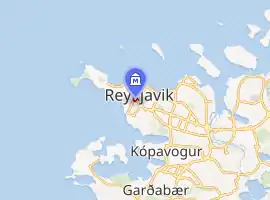National Museum of Iceland
The National Museum of Iceland (Þjóðminjasafn Íslands) was established on 24 February 1863, with Jón Árnason the first curator of the Icelandic collection, previously kept in Danish museums.[1] The second curator, Sigurður Guðmundsson, advocated the creation of an antiquarian collection, and the museum was called the Antiquarian Collection until 1911.
 Suðurgata 41, Reykjavík | |

| |
| Established | 24 February 1863 |
|---|---|
Before settling at its present location, at Suðurgata 41, 101 Reykjavík, in 1950, it was housed in various Reykjavík attics, finally for forty years in the attic of the National Library building on Hverfisgata (Safnahúsið, now the Culture House, Þjóðmenningarhúsið).
A key object in the permanent exhibition is the Valþjófsstaður door, a celebrated carving depicting a version of the Lion-Knight legend where a knight slays a dragon, thus freeing a lion that becomes his companion.
References
- Hallgrímsdóttir, Margrét; Kristmundsson, Ómar H. (2020-11-27). "A museum out of date? Changes in organizational legitimacy – the case of the National Museum of Iceland 1980–2001". Museum Management and Curatorship. 0 (0): 1–16. doi:10.1080/09647775.2020.1845970. ISSN 0964-7775.
External links
| Wikimedia Commons has media related to National Museum of Iceland. |
- Official website including information in English